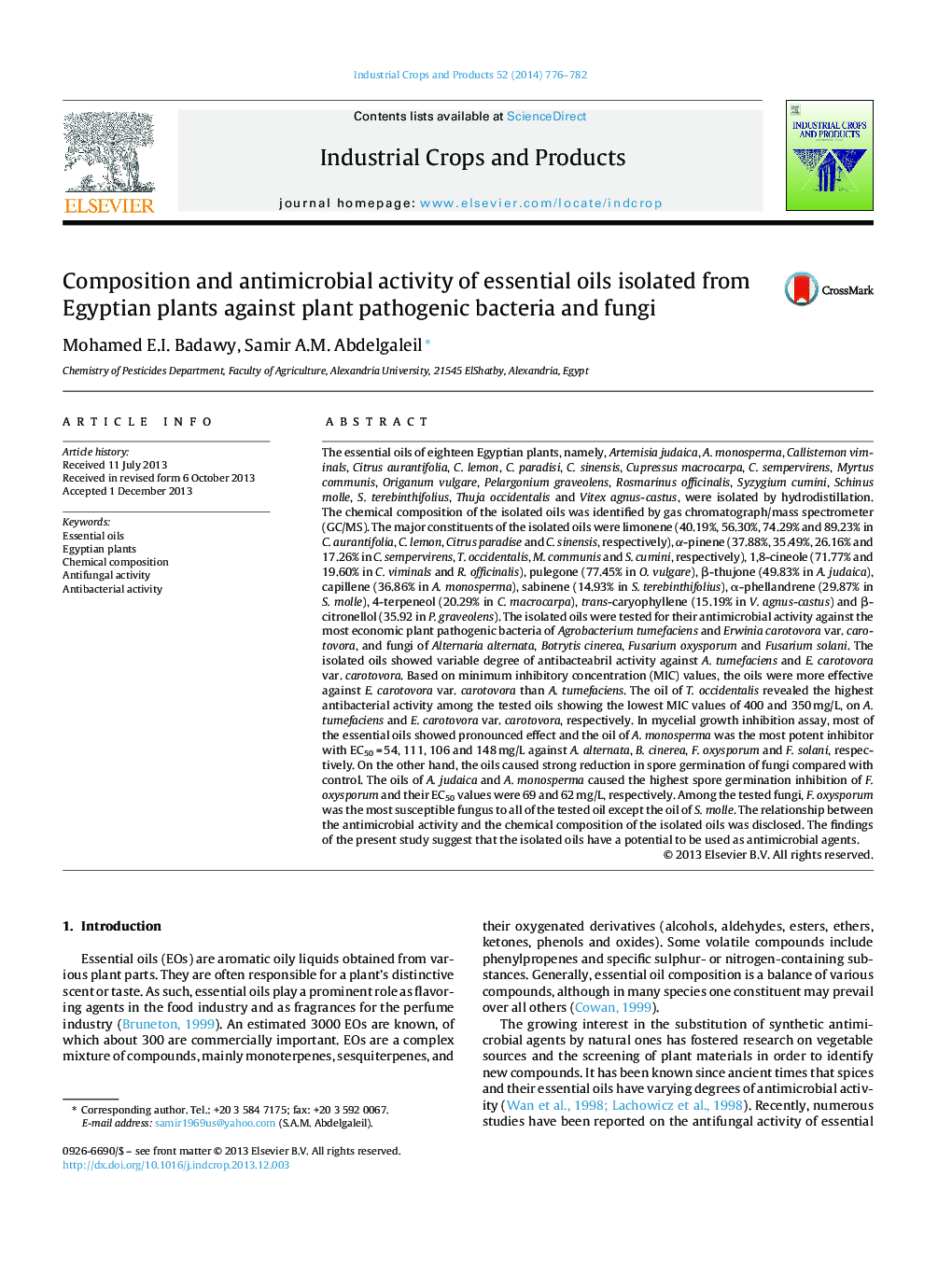| کد مقاله | کد نشریه | سال انتشار | مقاله انگلیسی | نسخه تمام متن |
|---|---|---|---|---|
| 4513441 | 1624857 | 2014 | 7 صفحه PDF | دانلود رایگان |
• Eighteen essential oils were isolated from Egyptian plants and their chemical composition was identified by GC/MS.
• The isolated oils showed pronounced antibacterial and antifungal activities against plant pathogenic bacteria and fungi.
• The relationship between chemical composition and antimicrobial activity was discussed.
The essential oils of eighteen Egyptian plants, namely, Artemisia judaica, A. monosperma, Callistemon viminals, Citrus aurantifolia, C. lemon, C. paradisi, C. sinensis, Cupressus macrocarpa, C. sempervirens, Myrtus communis, Origanum vulgare, Pelargonium graveolens, Rosmarinus officinalis, Syzygium cumini, Schinus molle, S. terebinthifolius, Thuja occidentalis and Vitex agnus-castus, were isolated by hydrodistillation. The chemical composition of the isolated oils was identified by gas chromatograph/mass spectrometer (GC/MS). The major constituents of the isolated oils were limonene (40.19%, 56.30%, 74.29% and 89.23% in C. aurantifolia, C. lemon, Citrus paradise and C. sinensis, respectively), α-pinene (37.88%, 35.49%, 26.16% and 17.26% in C. sempervirens, T. occidentalis, M. communis and S. cumini, respectively), 1,8-cineole (71.77% and 19.60% in C. viminals and R. officinalis), pulegone (77.45% in O. vulgare), β-thujone (49.83% in A. judaica), capillene (36.86% in A. monosperma), sabinene (14.93% in S. terebinthifolius), α-phellandrene (29.87% in S. molle), 4-terpeneol (20.29% in C. macrocarpa), trans-caryophyllene (15.19% in V. agnus-castus) and β-citronellol (35.92 in P. graveolens). The isolated oils were tested for their antimicrobial activity against the most economic plant pathogenic bacteria of Agrobacterium tumefaciens and Erwinia carotovora var. carotovora, and fungi of Alternaria alternata, Botrytis cinerea, Fusarium oxysporum and Fusarium solani. The isolated oils showed variable degree of antibacteabril activity against A. tumefaciens and E. carotovora var. carotovora. Based on minimum inhibitory concentration (MIC) values, the oils were more effective against E. carotovora var. carotovora than A. tumefaciens. The oil of T. occidentalis revealed the highest antibacterial activity among the tested oils showing the lowest MIC values of 400 and 350 mg/L, on A. tumefaciens and E. carotovora var. carotovora, respectively. In mycelial growth inhibition assay, most of the essential oils showed pronounced effect and the oil of A. monosperma was the most potent inhibitor with EC50 = 54, 111, 106 and 148 mg/L against A. alternata, B. cinerea, F. oxysporum and F. solani, respectively. On the other hand, the oils caused strong reduction in spore germination of fungi compared with control. The oils of A. judaica and A. monosperma caused the highest spore germination inhibition of F. oxysporum and their EC50 values were 69 and 62 mg/L, respectively. Among the tested fungi, F. oxysporum was the most susceptible fungus to all of the tested oil except the oil of S. molle. The relationship between the antimicrobial activity and the chemical composition of the isolated oils was disclosed. The findings of the present study suggest that the isolated oils have a potential to be used as antimicrobial agents.
Journal: Industrial Crops and Products - Volume 52, January 2014, Pages 776–782
